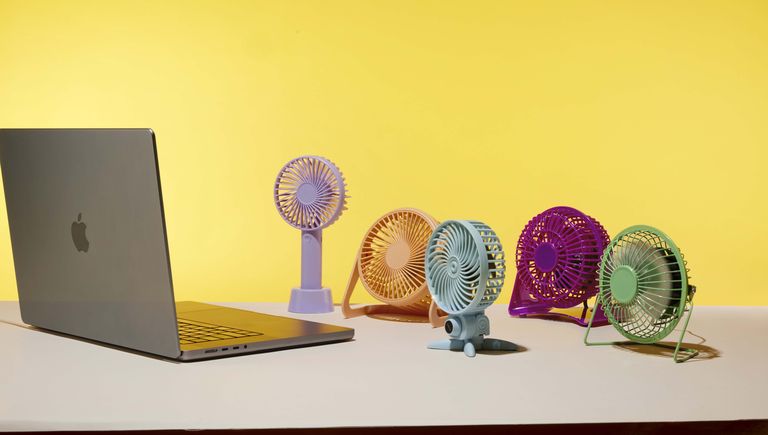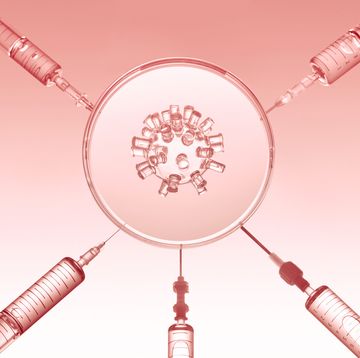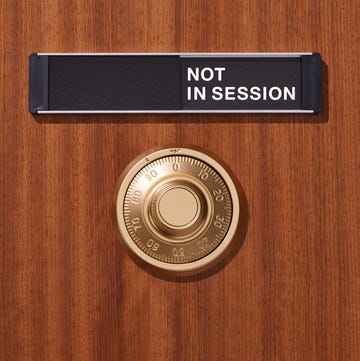Tamsen Fadal was 47 when her job—reporting the news from the anchor chair at WPIX-NY—suddenly became difficult. “I couldn’t read the teleprompter,” says Tamsen, now 52. It wasn’t that her eyes were failing or that the words were spelled wrong; it was that her brain, during those moments, couldn’t form the words—words she had spoken many times before that now made no sense to her at all. “I literally could not get them out of my mouth,” she says.
Tamsen, who had anchored the news for two decades, was seasoned enough to improvise her way through. But it started happening more often. She felt scared. And she was exhausted—barely sleeping at night, barely able to get out of bed in the morning. “I got tested for stroke, Alzheimer’s, heart problems,” she says. “I went to Western doctors, functional doctors, integrative doctors.” But nothing appeared to be wrong. Then in October 2019, during a commercial break, Tamsen’s heart began to pound at triple speed, her head feeling as if it were spinning off her neck. To no one in particular, she cried out, “If I fall, someone please catch me.” Seeing the fear in her eyes and the sweat on her face, one of her producers eased her off her high stool and escorted her to the bathroom, where she collapsed, her flaming red cheek finally cooling against the tile.
Get the support you deserve! Join our free webinar on Menopause in the Workplace on February 28 at 12 p.m. ET. Register now to hear from Tamsen Fadal and other advocates and experts. Brought to you by Prevention and HealthyWomen as part of Prevention’s Year of Making Noise initiative.
“I was so ashamed,” Tamsen says. “Here I was, an anchor who couldn’t read, who couldn’t remember anything.”
Yet despite all the doctors she went to for all her symptoms and all the antidepressants, antianxiety pills, and supplements she was prescribed, no one addressed or even acknowledged the root cause of her ills: menopause.
The facts about working women and menopause
Each day about 6,000 women in the United States reach menopause, marked by the 12-month absence of a menstrual period. Women typically hit the menopause milestone between the ages of 45 and 55, though 5% of women get there between 40 and 45. According to the U.S. Bureau of Labor Statistics, by 2024, 12% of the workforce, from factory employees to CEOs, will consist of women 55 and older. And most of those women—as many as 85% of them, according to some studies—experience at least one symptom, sometimes with such severity that whatever their profession, they have trouble doing their jobs.
Interestingly, women reach their earning peak at 44, more than 10 years before men do and at significantly lower salaries, according to the data company Payscale. And when a woman rises to a leadership role, it is more often during the first decade of her career than at any time after that, found a LinkedIn study. The reasons for this include the obvious ones: women taking time off to raise their families and, of course, the implicit sexism women in the workplace can’t seem to escape. Also, the 40s begin a period of unpredictability for many women, with sudden and conflicting demands ranging from aging parents to impulsive teenagers.
But consider this: Women are also, at the same time, entering perimenopause, often the most hormonally turbulent phase of the menopause transition, lasting an average of four to eight years. In this high-stress period, professional women don’t always have the mental or emotional bandwidth, let alone the societal support, to manage all these disruptions while pursuing the climb to the highest level in their careers. So it is that many professional women at the top of their game, like Tamsen, fall silent when it comes to talking about menopause. “Why would I tell someone that I can’t read the teleprompter anymore when I know there’s a 26-year-old waiting in the wings who can?” Tamsen asks. “Even if I couldn’t function at all I wouldn’t have said that. I have that fear that I will age out and be irrelevant.”
How menopause symptoms can affect your job
On average, menopause symptoms continue for four and a half years after a woman’s last period, though for some they can persist for 10 years or more. Those symptoms can include many that women have come to expect: hot flashes, weight gain, and vaginal dryness and atrophy. Other symptoms may come as a surprise: joint pain, urinary incontinence, intense depression and anxiety, insomnia and general fatigue, migraine, and—for many the most terrifying of all—memory loss and brain fog. About 20% of women suffer from severe menopause symptoms that can be debilitating, says Wen Shen, M.D., M.P.H., codirector of the Women’s Wellness & Healthy Aging Program at Johns Hopkins Medicine in Baltimore.
In fact, according to a new British survey of more than 4,000 women ages 45 to 55, one in 10 menopausal women has quit a job as a consequence of symptoms. Fourteen percent of the women surveyed reduced their hours, while another 14% went part-time. Eight percent of the women did not apply for a promotion. Not surprisingly, around 80% of them worked at companies without any sort of menopause protocol (which can include anything from information sharing to policies for menopause-related absences). Those statistics clearly underline what a 2010 study review showed: that women with negative attitudes toward menopause (and, honestly, considering its bad rap, who could blame them?) are more likely to report having worse symptoms.
Conversely, women who are educated about menopause and supported by their employers manage the transition more easily, often with fewer and less severe symptoms. A large survey of Australian perimenopausal and postmenopausal women working in higher education reveals that supervisor support is among the most significant factors in helping shift “the climate of silence and stigmatization” that typically defines menopause, making it easier for women to cope better with symptoms.
Without support, education, accommodations, and treatment, everyone pays. A 2014 review of health insurance claims of more than 500,000 perimenopausal and postmenopausal women showed that untreated vasomotor symptoms (VMS)—a.k.a. hot flashes—cost patients and their employers nearly $340 million a year. Women with VMS made 1.5 million more outpatient visits than those who did not suffer from VMS. And indirect costs, meaning loss of productivity through absenteeism or presenteeism (when someone is at work but unable to fulfill their duties) total almost $28 million.
“It’s very easy for an employer to change the environment,” says Philip Sarrel, M.D., emeritus professor of obstetrics, gynecology, reproductive science, and psychiatry at Yale University and lead author of the study. He points to the success of changes made at companies in Great Britain and Australia, including adjustments in office temperature, lighter work uniforms, and more flexible work hours.
“Menopause in the workplace is an economic argument,” says Stephanie Faubion, M.D., M.B.A., medical director of the North American Menopause Society (NAMS) and director of Mayo Clinic Women’s Health. Recently Dr. Faubion and her team surveyed more than 5,000 female primary care patients—most of them employed—about menopause symptoms and work. “The impact was shocking,” she says. “We asked, ‘Have you reduced your hours, missed days of work or a promotion, retired early, quit, or changed jobs?’ ” She says the results, to be published later this year, are “mind-boggling.”
“When you look at the overall picture, you realize, ‘Wow, this is a problem not just for women but for their employers and society, and we need to pay attention to it,’ ” Dr. Faubion says. And yet, she adds, “I have not heard of many corporations working on ways to accommodate employees impacted by menopause symptoms, but both employers and women themselves are losing economically if we don’t address these issues.”
In the U.K., a study published last May reported that nearly half of 4,014 women surveyed said menopause symptoms made their jobs more difficult. Four out of five of those women felt that their workplaces offered no support. “Leaving symptomatic menopausal women both unsupported and untreated is barbaric,” says Louise Newson, M.D., a menopause specialist and chair of the Newson Health Menopause Society, based in Stratford- Upon-Avon in the U.K. Dr. Newson recently conducted her own study of 3,800 midlife women in the workplace and discovered that 59% of them had taken time off work because of symptoms, nearly 20% for more than eight weeks. “If you have women you have trained up and you lose them, you need to pay their sick leave, recruit a replacement, and then train that person,” she says. “These are huge costs.”
The way we think about menopause is starting to change
Here in the U.S., menopause is finally having its day. Multiple virtual platforms, such as Midi and Alloy, have been created to offer menopause medical consultations with doctors and nurse practitioners. And products and treatments for menopause symptoms are sprouting into what is expected to become a $600 billion business within a couple of years. Still, companies whose workforces include (and may even be dominated by) midlife women, rarely acknowledge a phase of life that just about every one of their female employees will experience.
“Every week I have patients say, ‘I think I’m losing my mind,’” says Dr. Shen. “Many women reach the glass ceiling in their careers during the menopause transition or postmenopause. Severe symptoms during this phase of their lives can significantly impact their ability to perform, compete, and succeed. Surveys have found that some women will accept a lower position or even resign because the symptoms are so debilitating.” Lori Reynolds (name has been changed), 48, a personnel officer for the State of Connecticut, started having perimenopause symptoms prematurely, at age 35. In February 2020, she started getting vestibular migraines so intense, she says, “it felt like someone was hammering inside my head.” She was also exhausted and dizzy to the point of sometimes being unable to walk, had hot and cold sweats, and was constantly crying. “The silver lining was that we went into lockdown and I could work from home and take care of myself,” she says.
Yet in June 2021, when Lori returned to the office, she realized she needed additional support to deal with her symptoms. Her only relief came from thrice-weekly acupuncture visits, medical massages, and therapy visits to help her manage her depression and anxiety. She applied for Family Medical Leave Act benefits providing 12 weeks of unpaid leave per year, which she often takes in hourly increments. “If I’m having a tough time, I can say I’m coming in later,” she said. “But that’s against sick time or vacation time. If I run out of hours, I don’t get paid.”
Even when her office went hybrid in November 2021, Lori estimates that she missed as many as 10 hours a week. Despite never having missed a deadline, she feels she has been passed over for the many promotions she has applied for: “Even when you’re doing a good job, if you’re not logging enough face time, they’re not going to consider you the best person for the job.”
There are specific changes workplaces can make: Another study, in which Dr. Sarrel collaborated with Gavin Jack and his team at Monash University in Melbourne, Australia, found that women who worked full-time complained less about menopause symptoms when they received support from their super visors and had control over workplace temperature settings. In other words, when menopause is addressed openly and proactively, that can have a positive benefit on women’s well-being and productivity. “Cooling the room by just two degrees makes a difference. Providing desk fans makes a difference. Having someone hear you makes a difference,” says Dr. Sarrel.
That’s something Beth Screen (name has been changed), 52, discovered. She estimates that she missed two days of work per week at the end of her job at a real estate association. “There were times when I was so sad, but I didn’t want my staff to see me teary-eyed,” says Beth, so she often filled her days with out-of-office meetings. “Sometimes I just needed to sit under a tree and try to understand my emotions.” The CEO of the association attempted to comfort her by saying he knew a lot of women of a certain age “made hysterical” by menopause. Says Beth: “I knew never to fall apart in front of him again.” She now works in a female-dominated office that requires employees to take all their vacation days and mental health days when needed. Now on hormone therapy, she still has occasional symptoms, mostly the sudden onset of depression. But she no longer feels as if she has to sneak away to deal with them. “I get empathy instead of being misunderstood or tolerated,” she says.
Back in her anchor chair, Tamsen Fadal no longer misreads words and stumbles through sentences. Her first step toward well-being was seeing a gynecologist certified by NAMS, who explained that she wasn’t dying or going mad—she was in menopause. Her second step was educating herself enough to understand that hormone replacement in a dosage tailored for her would not likely trigger the estrogen-based breast cancer that killed her mother at age 51. Most important, Tamsen let go of her fear of speaking about menopause and gave it a voice in her own newsroom.
“I now say, ‘I’m having a hot flash, please turn down the temperature,’ ” says Tamsen, who is producing a documentary called, It’s Not Me…It’s Menopause. “I’ve opened up the conversation here so women can speak up without feeling that this natural cycle in their lives will be held against them.”
How to protect yourself during menopause
More than 75% of women will experience bothersome symptoms, and most don’t get treated for them despite the fact that treatments do exist, says Stephanie Faubion, M.D., medical director of the North American Menopause Society (NAMS). And many medical professionals lack the training to adequately address symptoms or are misinformed about the value and safety of hormone therapy.
The best way to both prepare and protect yourself is to consult with a NAMS certified medical professional even before your last menstrual period occurs. You may not only improve the quality of your life, but also shield yourself from osteoporosis and more. “The benefits of hormone therapy are even more pronounced for women who undergo menopause early (before age 45) or prematurely (before age 40). For those women, hormone therapy is needed to protect the bones, brain, and heart,“ says Dr. Faubion.
How workplaces can support people in perimenopause and menopause
Just a few simple changes: an attitude shift, minor accommodations in the work environment, and some essential education on the medical, psychological, and emotional impact of the menopause transition. That’s all that is needed to help keep America’s female workforce productive from perimenopause into postmenopause, says Minnesota gynecologist Rachel Cady, M.D.
“It’s astonishing that we deliver babies and perform hysterectomies but don’t address a life event every woman goes through,” says Dr. Cady, who noted the divide whenever one of her smart, educated, and successful midlife patients sat before her wondering if she was fit to continue doing her job. Dr. Cady is among a handful of physicians nationwide trying to push menopause into the consciousness of employers, managers, and HR staff, starting with her own hospital in Crosby, MN. That’s how she came to run the Cayuga Regional Medical Center’s new menopause clinic.
Here’s what helps in a workplace environment:
- Managers and HR personnel who are educated about menopause
- Well-ventilated work spaces, whether a corner office or a factory floor
- Desk or neck fans
- Flexible work hours/ job sharing
- Sanitary products for extremely heavy days
- Places to store extra clothes in case someone bleeds through theirs
- Lighter/thinner work uniforms
“This is low cost for high yield,” says Dr. Cady. “We can do better, and we should.”














